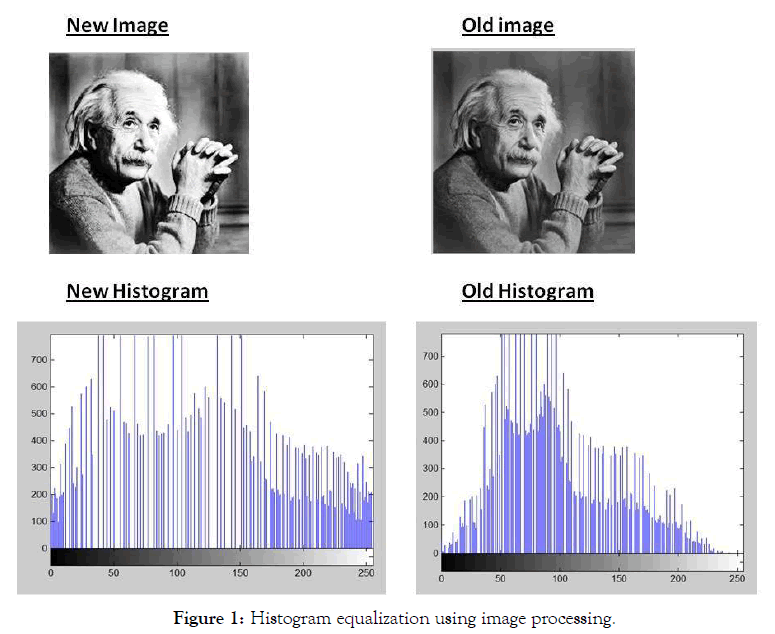Journal of Information Technology & Software Engineering
Open Access
ISSN: 2165- 7866
+44 1300 500008
ISSN: 2165- 7866
+44 1300 500008
Short Communication - (2019)Volume 9, Issue 1
Image upgrade can be considered as one of the principal forms in picture examination. The objective of difference upgrade is to improve the nature of a picture to wind up additional appropriate for a specific application. Till today, various picture upgrade techniques have been proposed for different applications and endeavours have been coordinated to additionally build the nature of the upgrade results and limit the computational intricacy and memory utilization. In this paper, an image improvement strategies dependent on Histogram Equalization (HE) was considered.
Histogram Equalization (HE); Noise; Image; Picture
Histogram equalization applications are regularly executed for image handling in restorative use, voice acknowledgment, incorporating surfaces and that's only the tip of the iceberg. As of late, the usage of the histogram evening out strategy to upgrade picture has been an intriguing subject. A procedure that has been create where pictures controlled from its pixel force to make a picture that outwardly more prominent, called Image upgrade. The reason for existing are to upgrade pictures for human outwardly by improving the understanding of data contained in it, or likewise the outcome can be utilized as a high calibre contribution for more picture handling use.
From many proposed image upgrade strategy over years, balance of histogram has turned into the most prominent picture improvement utilized. The technique for the most part actualized in picture improvement process in view of its usability, a higher execution and yield with practically all sort of picture. With the control the dimension of dim dependent on the appropriation likelihood, an picture can be improved. That changes and improve the dimension of difference of the pictures by controlling powerful range from the histogram, where its stretches and straighten dependent on the strategy [1].
The procedure is done utilizing an assortment of techniques relying upon the normal conditions on the picture, for example, honing certain parts of the picture, expelling noise or impedance, differentiate control and dark scale, and so on. Noise is the focuses in the picture that are not entirely of the picture, however are blended in the picture which is as it should be. Commotion emerges generally because of inadequately quieted (clamour sensors, photographic increase clamour) [2]. The confusion is commonly a variety in the force of a pixel that does not correspond with neighbouring pixels. Outwardly, the turmoil is effectively observed by the eye as it appears to be unique from its neighbouring pixels. Pixels with unsettling influences for the most part have high recurrence. Parts of low recurrence pictures by and large have consistent pixel esteem or change very gradually [3].
The picture improvement process is: picture splendor, differentiate extending, histogram evening out, picture smoothing, honing edge, pseudo colouring, geometric changes. For the most part, picture quality improvement is done through picture histogram portrayal through histogram evening out strategy. This technique works by depicting the appropriation of pixels in a histogram by changing the dark level estimation of specific pixels paying little heed to its area in a picture. The histogram picture is an esteem that permits to be utilized as an outline of the power of a picture [4] (Figure 1).

Figure 1: Histogram equalization using image processing.
A computerized picture handling programming has been effectively developed. The product can do picture differentiate improvement with histogram evening out technique. The outcomes given by the strategy equalization histogram can improve picture quality, so that data in the picture all the more obviously noticeable.
Citation: Veernala S, Latha L, Anuradha A, Phani Kumar N (2019) Deployment and Use of Mobile Technology to Control Malaria. J Inf Technol Softw Eng 9:254.Doi: 10.35248/2165-7866.19.9.254
Received: 26-Feb-2019 Accepted: 03-Mar-2019 Published: 14-Mar-2019 , DOI: 10.35248/2165-7866.19.9.254
Copyright: © 2019 Veernala S, et al. This is an open-access article distributed under the terms of the Creative Commons Attribution License, which permits unrestricted use, distribution, and reproduction in any medium, provided the original author and source are credited.